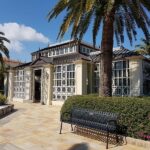Past Forward: Native American Art from Gilcrease Museum is the first exhibition to showcase the collection’s outstanding strength in Indigenous art, rooted in the connoisseurship of a Native philanthropist.
Past Forward: Native American Art from Gilcrease Museum showcases the extensive collection of Indigenous art created by Thomas Gilcrease (1890 –1962), an arts patron and a citizen of the Muscogee Nation. Gilcreaseʼs unprecedented efforts and devotion to Indigenous traditions — continued today by Gilcrease Museum — affirmed these works as vital to American art history. Surveying more than 3,000 years of Native American art, this enriching and illuminating exhibition encompasses portraiture, archaeological, and archival works, allowing for exploration of visual motifs and shared systems of knowledge that connect different ancestries, time, and space.
American oilman Thomas Gilcrease, the founder of Gilcrease Museum, was of Muscogee (Creek) ancestry and sought to tell the story of the United States through art that emphasized Native cultures and the history of the American West. As scholars and curators increasingly embrace the imperative to foreground Native perspectives, Gilcrease Museum is distinct for having been shaped by the tastes and interests of an Indigenous collector who maintained personal relationships with a number of the Native artists whose works he acquired. Whereas Gilcrease Museum’s holdings of Western art by artists such as Charles Russell and Frederic Remington have been the focus of previous traveling exhibitions, Past Forward is the first to showcase Gilcrease Museum’s remarkable Indigenous art collections.
Past Forward takes a thematic approach to Native American art history, considering ways in which Indigenous artists across time have conceptualized and represented similar subjects. The exhibition will be structured around transhistorical themes each featuring two- and three-dimensional Indigenous objects ranging from ancient to contemporary. Works within the first thematic section highlight the use of visual abstraction in Indigenous art and are intended to foster an appreciation of how abstraction plays an integral role in sustaining tribal wisdom across generations. The next section focuses on ceremonial events, which serve in Indigenous communities to ensure the continuity of all creation and to perpetuate the balance of the universe, while the third section examines issues of sovereignty, and how artists have pictured relationships between autonomous communities. Past Forward culminates in an exploration of the ways in which many artists have determinedly negotiated their Indigenous identities in relation to Euro-American visual and cultural traditions.
Across all the sections, a small selection of comparative works by Euro-American artists such as Russell and George Catlin will help underline the distinctive visual languages found within Native art that form the exhibition’s primary focus.
In addition to offering an overview of Indigenous visual culture through highlights from Gilcrease Museum, Past Forward also amplifies the perspectives of Native community members, scholars, and artists through the exhibition’s multi-vocal interpretive program and catalogue entries that feature varied Indigenous perspectives. At a time when marginalized peoples across North America are uniting to magnify their voices in the fight for socio-political reform, it is even more crucial to provide spaces in which members of these communities can present their own histories, cultures, and modes of expression. Spotlighting works created and collected by Native individuals, Past Forward: Native American Art from Gilcrease Museum helps contribute to the widening narrative of American art history.
ITINERARY



PUBLICATION
Past Forward: Native American Art from Gilcrease Museum is accompanied by a free educational brochure developed by the AFA.
CO-ORGANIZERS
Founded in 1949, the Thomas Gilcrease Institute of American History and Art, commonly known as Gilcrease Museum, has a vast collection of American art, including an unparalleled selection of Native American art and material. The Helmerich Center for American Research on the Museum’s campus houses the extensive archive that Thomas Gilcrease amassed. Gilcrease Museum is dedicated to bringing art, history, and people together to encourage research, discovery, enjoyment, and understanding of the diverse heritage of the Americas. The Museum founder’s fundamental interest in Native cultures was due in part to his own Muscogee (Creek) ancestry. Gilcrease was patron to a number of Native American artists of his time and purchased over five hundred paintings by twentieth-century Native artists. As a result, the museum not only tells the story of Native Americans through the exhibition of objects that are thousands of years old but also through recent paintings and sculptures.
GUEST CURATORS
Chelsea M. Herr (Choctaw Nation of Oklahoma) is the Jack & Maxine Zarrow Curator for Indigenous Art and Culture at Gilcrease Museum in Tulsa, Oklahoma. She earned a PhD from the University of Oklahoma, writing a dissertation on Indigenous Futurisms in the work of Native North American artists. She recently guest curated Stitched in Sovereignty: Contemporary Beadwork from Indigenous North America at the Couse-Sharp Historic Site in Taos, New Mexico, and guest co-curated Indigenous Futurisms: Transcending Past/Present/Future at the Museum of Contemporary Native Arts in Santa Fe.
Janet Catherine Berlo, Professor of Art History and Visual and Cultural Studies Emerita at the University of Rochester, holds a PhD in History of Art from Yale. She is the author of Native North American Art (with Ruth Phillips, second edition 2015), Plains Indian Drawings 1865–1935 (the catalogue for an AFA traveling exhibition, 1998), Spirit Beings and Sun Dancers: Black Hawk’s Vision of a Lakota World (2000), Arthur Amiotte: Collages 1988–2006 (2006), José Bedia: Transcultural Pilgrim (with Judith Bettelheim, 2011), and many other publications on the arts of the Americas.











